“Nothing Else Matters” is a timeless rock ballad known for its emotional depth and melodic simplicity, making it a popular choice for pianists seeking expressive sheet music.
1.1. Background of the Song and Its Composer
“Nothing Else Matters” was written by Metallica’s lead vocalist and guitarist James Hetfield, with credit also given to Lars Ulrich and Kirk Hammett. Released in 1992 on the self-titled “Metallica” album, it stands as one of the band’s most introspective and emotionally resonant tracks. The song’s melancholic melody and heartfelt lyrics, inspired by Hetfield’s personal experiences, have made it a fan favorite and a staple of rock music. Its simplicity and depth translate beautifully to piano, making it a popular choice for arrangements.
1.2. Why “Nothing Else Matters” Is a Popular Choice for Piano
The song’s emotional depth and melodic simplicity make it a favorite for pianists. Its hauntingly beautiful melody translates well to the piano, allowing for expressive interpretations. The ballad’s intimate nature aligns perfectly with the piano’s capabilities, creating a powerful connection with listeners. Additionally, the song’s versatility enables pianists to add personal touches and creativity, making it a popular choice for both beginners and advanced players seeking to evoke deep emotions through music.
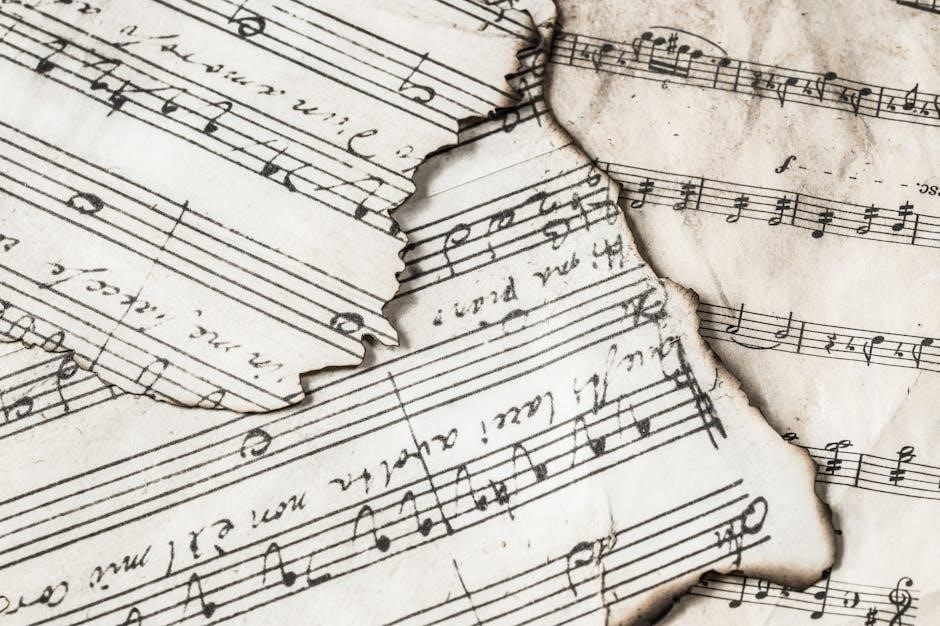
Understanding the Sheet Music for Piano
Understanding the sheet music for “Nothing Else Matters” involves recognizing its melodic structure, chord progressions, and emotional nuances, ensuring a faithful rendition of the song’s essence on piano.
2.1. What to Expect in the Sheet Music
The sheet music for “Nothing Else Matters” typically includes the melody, chord progressions, and lyrics, adapted for piano. It often features a mix of arpeggios and simple harmonies, capturing the song’s emotional essence. You’ll find variations in dynamics, with soft passages building to powerful crescendos. The arrangement may also include introspective interludes and a memorable guitar solo translated for piano. Tempo remains steady, allowing pianists to focus on expression. The sheet music is designed to balance simplicity with complexity, making it accessible to players of various skill levels while maintaining the song’s original depth.
2.2. Key Signature and Tempo
The sheet music for “Nothing Else Matters” is typically written in the key of A minor, creating a somber yet introspective mood. The tempo is moderate, around 96 BPM, allowing for a steady, reflective pace that emphasizes emotional expression. Pianists will encounter chord progressions and arpeggios that align with the song’s iconic guitar riffs, while maintaining a consistent rhythm. The key and tempo guide the player in capturing the song’s dynamic shifts and maintaining its heartfelt, melodic flow throughout the performance.
2.3. Dynamics and Expression Markings
Dynamics in “Nothing Else Matters” play a crucial role in conveying emotion. The sheet music includes markings like piano, forte, and crescendo to guide intensity changes. Expression markings such as legato and rubato emphasize the song’s melodic flow and emotional depth. Pianists must pay attention to these cues to capture the introspective and powerful moments, ensuring a balanced performance that resonates with the original’s heartfelt essence. Proper interpretation of dynamics and expressions is key to delivering an authentic rendition of this beloved ballad.

Where to Find “Nothing Else Matters” Sheet Music for Piano
The sheet music for “Nothing Else Matters” is widely available online as piano arrangements, accessible through official sources, music platforms, and dedicated sheet music websites.
3.1. Official Sources for Sheet Music
Official sources like Metallica’s website and Hal Leonard provide authentic and legally licensed sheet music for “Nothing Else Matters.” These platforms ensure high-quality arrangements, often reviewed by the artists or their teams. Purchasing from official sources supports the creators and guarantees accuracy in the composition. Additionally, these sites frequently offer various formats, including PDF, making it easy to download and print. Always prioritize official sources to avoid illegal copies and ensure a professional performance experience.
3.2. Popular Websites for Piano Sheet Music
Popular websites like Musicnotes, Sheet Music Plus, and Piano Nanny offer a wide range of sheet music for “Nothing Else Matters.” These platforms cater to pianists of all skill levels, providing both free and paid versions. Websites like MuseScore and Piano Sheet Music also feature user-contributed arrangements, offering diverse interpretations. When searching, ensure the source is reputable to download accurate and high-quality PDF files. These sites are great for accessing sheet music quickly and conveniently, whether you’re a beginner or an advanced pianist.
3.3. Free vs. Paid Sheet Music: Pros and Cons
Free sheet music is cost-effective and accessible, ideal for beginners or casual players. However, it may lack accuracy or be incomplete. Paid sheet music offers high-quality, accurate arrangements and supports creators but requires a budget. Free options are great for exploration, while paid versions ensure reliability and professionalism. Consider your needs, skill level, and budget when choosing between the two. Paid sheet music often provides better quality and durability for serious pianists.

Choosing the Right Version of the Sheet Music
Choosing the right version of “Nothing Else Matters” sheet music ensures a satisfying playing experience. Consider arrangement type, skill level, and personal preference to find the perfect fit.
4.1. Simplified vs. Original Arrangements
When selecting sheet music for “Nothing Else Matters,” pianists often choose between simplified and original arrangements. Simplified versions reduce complexity, making the piece accessible to beginners, while original arrangements retain the song’s intricate details and emotional depth. Beginners may prefer simplified versions to focus on melody and basic harmonies, whereas experienced players might opt for original arrangements to capture the full essence of the song, including nuanced chord progressions and dynamics.
4.2. Difficulty Levels Available
The sheet music for “Nothing Else Matters” is available in various difficulty levels, catering to pianists of all skill levels. Beginners can opt for simplified arrangements with basic chords and melodies, while intermediate players may enjoy versions with moderately complex harmonies. Advanced pianists can explore intricate arrangements that mirror the original composition’s depth. This range ensures that pianists can select a version that aligns with their technical proficiency, allowing for a smooth learning curve and gradual progression.
4.3. How to Select the Version That Suits Your Skill Level
To choose the right version of “Nothing Else Matters” sheet music, assess your current skill level and familiarity with the song. Consider the original arrangement’s complexity and opt for a simplified version if you’re a beginner. Start with basic arrangements and gradually move to more intricate versions as your skills improve. Utilize difficulty ratings or previews to gauge suitability. This approach ensures a smooth learning process and allows you to enjoy playing while challenging yourself appropriately.

Tips for Playing “Nothing Else Matters” on the Piano
Start with a slow tempo, focus on smooth transitions, and emphasize emotional expression. Practice finger placement and dynamics to capture the song’s heartfelt essence effectively.
5.1. Finger Placement and Hand Positioning
Keep your hands in a relaxed position with fingers curved gently over the keys. Avoid stretching excessively; instead, focus on precise finger placement to maintain control. Use finger numbers 1-5 for both hands, ensuring a natural reach. Prioritize playing melody notes with your right-hand thumb and index finger for clarity. For chord progressions, distribute fingers evenly to avoid muddiness. Pay attention to hand shifts between octaves, using the sustain pedal when necessary. Practice finger independence to achieve a smooth, flowing performance.
5.2. Arpeggios and Chord Progressions
The song features flowing arpeggios that create a soothing atmosphere, particularly in the verses. Practice playing these arpeggios smoothly, focusing on even rhythm. The chord progressions are central to the song’s emotional impact, transitioning between minor and major chords. Emphasize the melody’s top notes to highlight its expressive qualities. Use rolling chords to mimic the guitar’s strumming pattern. Start slowly, ensuring accuracy, then gradually increase speed. Dynamics and expression are key to conveying the song’s depth effectively.
5.3. Emphasizing Emotional Depth in the Melody
To capture the emotional essence of “Nothing Else Matters,” focus on the melody’s phrasing and dynamics. Play with a gentle, expressive touch, using rubato to convey longing. Emphasize the top notes in arpeggios to highlight the melody’s contours; Pay attention to subtle dynamic shifts, playing softer in quieter sections and allowing the melody to swell in louder passages. This approach ensures the emotional core of the song resonates deeply, making your performance compelling and heartfelt.
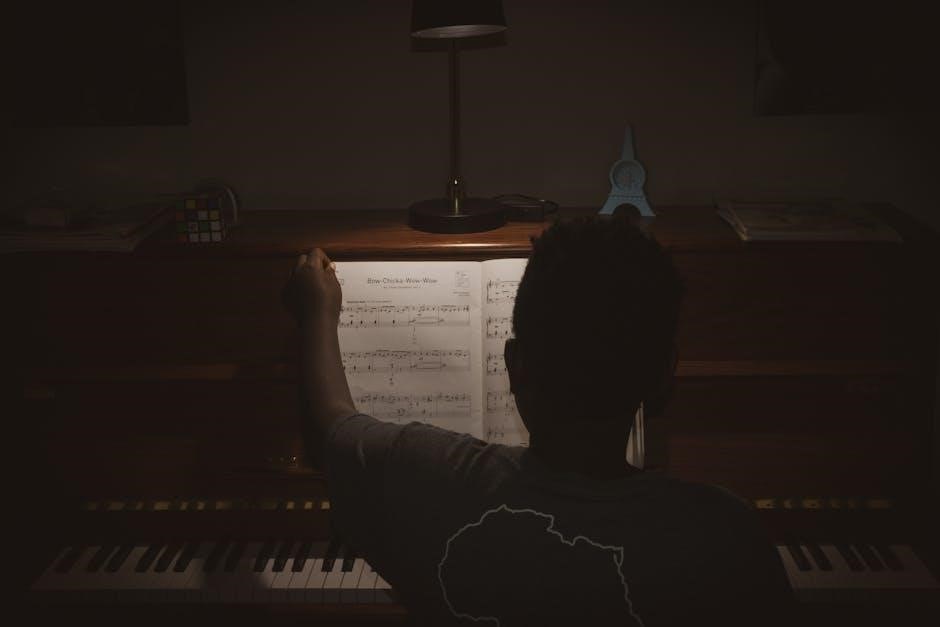
Common Challenges When Playing the Piece
Pianists often struggle with intricate chord transitions, maintaining consistent tempo, and technical intricacies, requiring patience and dedicated practice to master the piece effectively.
6.1. Navigating Complex Chord Transitions
The song’s chord progressions can be challenging due to rapid harmonic shifts and intricate finger movements. Pianists must focus on smooth transitions between chords to maintain the piece’s emotional flow. Practice slow tempos to build dexterity and accuracy. Breaking the piece into smaller sections can help master difficult passages. Pay attention to hand positioning to reach chords effortlessly. Consistent practice will refine your ability to navigate these transitions seamlessly, ensuring a polished performance.
6.2. Maintaining the Correct Tempo
Maintaining the correct tempo in “Nothing Else Matters” is crucial for preserving its emotional essence. The song’s slow, introspective nature demands a steady, unwavering pace. Practice with a metronome to ensure consistency, especially during dynamic shifts. Be mindful not to rush or drag, as this can disrupt the piece’s haunting beauty. Pay attention to fermatas and pauses, which add dramatic tension. A well-controlled tempo will allow the melody to resonate deeply, capturing the song’s heartfelt emotion and connecting with listeners on a deeper level.
6.3. Overcoming Technical Difficulties
Technical challenges in “Nothing Else Matters” often arise from arpeggios and complex chord transitions. To overcome these, break the piece into smaller sections and practice hands separately. Focus on finger independence and precise placement. Slow practice with a metronome can help master intricate passages. Additionally, pay attention to sustaining notes and dynamic control. Regular practice and patience are key to refining technique. Utilize tutorials or a teacher for guidance on tricky segments to ensure a polished performance.

The Role of Dynamics in “Nothing Else Matters”
Dynamics are essential for capturing the emotional build-up and subtle contrasts in “Nothing Else Matters.”
Balancing loud and soft sections ensures the music’s emotional impact remains intact.
They guide the pianist in interpreting the melody with feeling and intensity.
7.1. Understanding Crescendos and Decrescendos
Crescendos and decrescendos are vital for shaping the emotional journey of “Nothing Else Matters.”
A crescendo (gradual increase in volume) builds intensity, often leading to climactic moments, while a decrescendo (gradual decrease) creates subtle, reflective transitions.
Both markings guide pianists in expressing the song’s dynamic contrasts, enhancing its emotional depth and connection with listeners.
7.2. How to Use Pedals Effectively
Using the sustain pedal can enhance the lush, resonant sound of “Nothing Else Matters,” especially during chord progressions and arpeggios.
Press the pedal after playing key chords to allow notes to linger and blend, mimicking the guitar’s original texture.
The soft pedal can subtly mellow the sound in quieter sections, adding emotional intimacy.
Experiment with pedal timing to avoid muddiness while maintaining the song’s ethereal quality.
7.3. Balancing Loud and Soft Sections
Balancing loud and soft sections in “Nothing Else Matters” is crucial for capturing its emotional essence.
Start with a gentle touch during softer passages, gradually increasing dynamics for the crescendos to maintain contrast and depth.
Pay attention to phrasing, ensuring smooth transitions between quiet and powerful moments to preserve the song’s emotional flow.
Practice controlling your touch and dynamics to convey the raw emotion and intensity of the original composition.
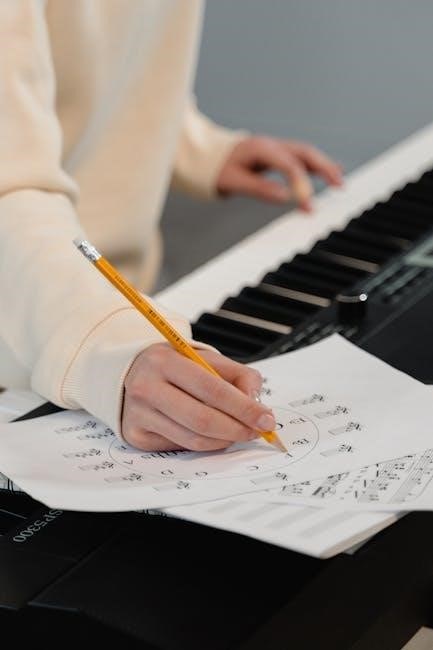
The Importance of Practice
Consistent practice is essential to master “Nothing Else Matters” on piano, ensuring technical accuracy and emotional expression in your performance.
8.1. Setting a Daily Practice Routine
Establishing a consistent practice routine is crucial for mastering “Nothing Else Matters.” Begin with warm-ups and scales to prepare your hands. Dedicate 15-30 minutes daily to focus on specific sections of the piece. Break the song into manageable parts, practicing each until comfortable. Include time for reviewing progress and refining challenging areas. End with a cool-down to relax your hands. Consistency will enhance your technical skills and emotional delivery. Adjust the routine based on your skill level and goals.
8.2. Breaking the Piece into Manageable Sections
Dividing “Nothing Else Matters” into smaller sections simplifies learning. Identify challenging parts, such as intricate chord progressions or emotional crescendos, and focus on mastering each segment. Start with the iconic intro, then move to the verse and chorus. Allocate practice time to each section, ensuring smooth transitions between them. This method allows for gradual progress and builds confidence. As you improve, combine sections to play the piece seamlessly, maintaining its emotional flow and intensity throughout.
8.3. Recording Yourself for Improvement
Recording your piano performance helps identify areas for improvement. Listen back to pinpoint mistakes, refine dynamics, and enhance expression. Regularly tracking progress boosts confidence and reveals growth. Use recordings to compare your interpretation with the original or professional covers. Analyze tempo consistency, emotional depth, and technical accuracy; This practice fosters self-awareness and motivates you to refine your skills. Over time, you’ll notice significant improvement in your ability to convey the song’s emotional core authentically.
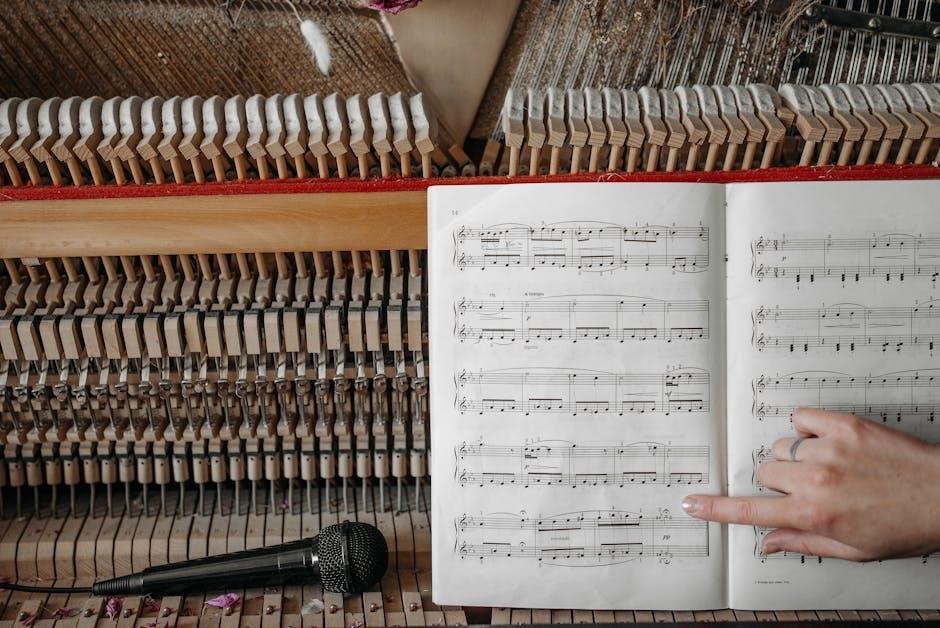
The Piano’s Role in the Original Song
The piano subtly enhances the emotional layers of “Nothing Else Matters,” providing a delicate foundation that underscores the song’s introspective and melancholic essence, supporting the guitar melody beautifully.
9.1. The Original Composition and Instrumentation
The original “Nothing Else Matters” was composed by Metallica’s lead vocalist and guitarist, James Hetfield, with contributions from lead guitarist Kirk Hammett. The song features a simple yet powerful guitar melody, accompanied by a haunting harmony. The instrumentation includes clean guitars, a prominent bass line, and subtle drumming, creating a melancholic and introspective atmosphere. The structure includes verses, a chorus, a guitar solo, and a bridge, all contributing to its emotional depth. The piano adaptation must capture this essence while translating the guitar-driven composition.
9.2. Translating Guitar Parts to Piano
Translating the iconic guitar parts of “Nothing Else Matters” to piano requires careful adaptation. The song’s arpeggio-based melody and chord progressions can be replicated using broken chord techniques or fingerpicking patterns. The guitar’s clean, muted tones and harmonized leads can be mimicked through legato playing and pedal sustain. Pianists must maintain the song’s emotional weight by preserving the intimate, introspective feel of the original composition while translating the guitar’s expressive nuances into a keyboard context.
9.3. Maintaining the Emotional Core of the Song
Maintaining the emotional core of “Nothing Else Matters” on piano requires capturing its raw vulnerability and introspective mood. Dynamics and tempo must align with the song’s original intent, ensuring soft passages evoke gentle reflection while crescendos convey emotional intensity. Phrasing and subtle pauses are key to preserving the heartfelt lyrics’ essence. Pianists should focus on expressing the melody’s melancholic beauty while staying true to the song’s emotional depth, making every note resonate with feeling and authenticity.
Famous Covers and Interpretations
“Nothing Else Matters” has inspired countless covers, with pianists worldwide offering unique interpretations. Famous pianists like Ludovico Einaudi and Max Richter have reimagined the song, adding their distinct styles while preserving its emotional essence.
10.1. Notable Piano Covers of “Nothing Else Matters”
Several pianists have created captivating renditions of “Nothing Else Matters,” each bringing their unique style. Artists like Peter Bence and Max Richter have reimagined the song with stunning arrangements; Bence’s emotional, intricate interpretations and Richter’s minimalist, contemporary take showcase the piece’s versatility. These covers not only highlight the song’s timeless beauty but also inspire pianists to explore their own interpretations. Exploring such renditions can provide valuable insights and motivation for mastering the piano sheet music.
10.2. How Different Artists Interpret the Song
Different artists bring unique perspectives to “Nothing Else Matters,” altering tempo, dynamics, and emotional depth. Some pianists add intricate improvisations, while others emphasize minimalism. Genres like classical or jazz are often blended, showcasing versatility. These interpretations offer inspiration for pianists to explore their own creative voice and style. Each rendition highlights the song’s adaptability, encouraging personal expression and growth in mastering the piano sheet music.
10.3. Learning from Other Pianists’ Performances
Learning from other pianists’ performances of “Nothing Else Matters” offers valuable insights. Observing their techniques, such as finger placement and dynamics, can enhance your own playing. Pay attention to how they handle complex sections and maintain emotional depth. Analyzing different interpretations allows you to explore new styles and incorporate elements that resonate with you into your performance. This process fosters creativity and helps refine your skills, making your rendition unique and expressive.
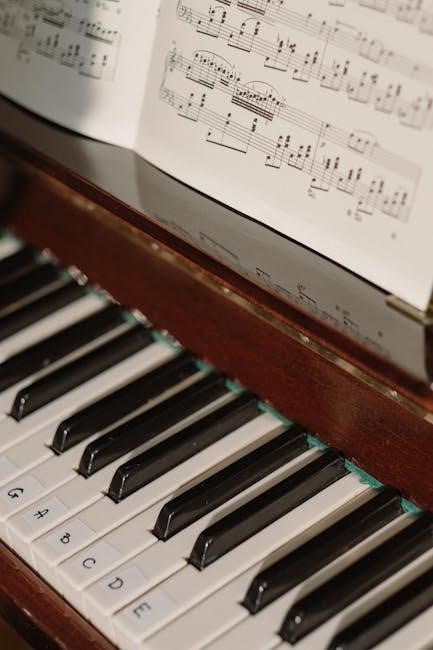
Adding Your Own Touch to the Performance
Adding your own touch to “Nothing Else Matters” allows for personal expression. Experiment with tempo, dynamics, or improvisation to create a unique interpretation that reflects your musicality.
11.1. Experimenting with Different Styles
Experimenting with different styles can breathe new life into “Nothing Else Matters.” Try adapting the melody to jazz, classical, or blues genres for a fresh twist. Jazz could incorporate improvisation, while classical arrangements might emphasize intricate harmonies. A blues interpretation could highlight soulful, melancholic undertones. Each style offers a unique perspective, allowing you to explore the song’s versatility and express your individuality. This creative approach keeps the piece engaging and personal, making it a meaningful part of your repertoire.
11.2. Incorporating Improvisation
Incorporating improvisation into “Nothing Else Matters” allows you to infuse the piece with personal creativity. Start by experimenting with the melody, adding embellishments or subtle variations. You can also explore harmonic improvisation by altering chord voicings or introducing unexpected progressions. Keep the song’s emotional essence intact while expressing your unique interpretation. Improvisation adds a dynamic layer, making each performance feel fresh and personal. It’s a powerful way to connect with the music on a deeper level and showcase your artistic voice.
11.3. Making the Piece Your Own
Making “Nothing Else Matters” your own involves personalizing the arrangement to reflect your style and emotion. Experiment with tempo variations or dynamic shifts to create a unique feel. Consider adding arpeggios or varying chord progressions to enhance the melody. Incorporate your musical personality, whether through classical nuances, jazz improvisations, or contemporary twists. This allows the song to resonate with your artistic voice while maintaining its core emotional impact. Personalization transforms the piece into a heartfelt, individualized performance.
Mastering “Nothing Else Matters” on piano is a rewarding journey, blending emotional depth with technical skill, leaving a lasting impression on both player and listener.
12.1. Final Thoughts on Playing “Nothing Else Matters” on Piano
Playing “Nothing Else Matters” on piano is a deeply rewarding experience, allowing pianists to connect with the song’s emotional core. While it presents technical challenges, the piece also offers opportunities for expressive interpretation. Balancing precision with feeling is key to capturing its essence. As you master the melody and harmonies, remember to embrace the song’s emotional depth, making it resonate uniquely with your audience. The journey of learning this piece is as enriching as the final performance itself.
12.2. Encouragement for Continuing to Learn and Grow
Congratulations on dedicating time to learn “Nothing Else Matters” on piano! Embrace the journey of improvement, as each note brings you closer to mastering this beloved piece. Stay curious, explore new techniques, and let the music inspire you. Remember, growth as a pianist is a lifelong adventure. Celebrate small victories, stay persistent, and enjoy the process of refining your skills. Keep exploring, and let the beauty of music continue to enrich your life and touch the hearts of those who listen.